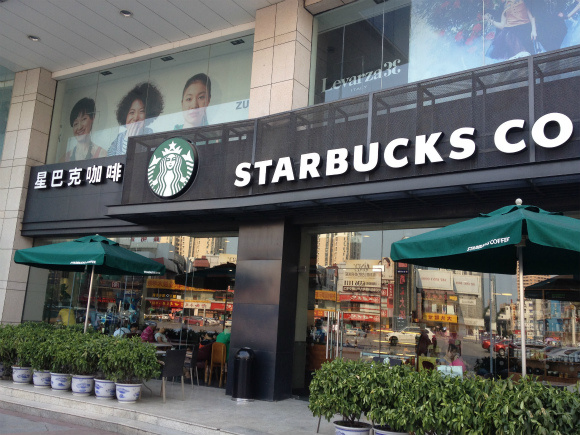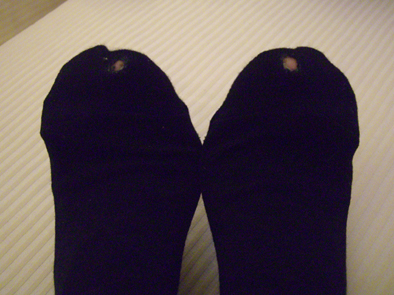
It’s safe to say that no one you see at Starbucks is there because they want to stretch their java-buying budget. With locations in more than 60 countries (and seemingly every branch in the Tokyo area at maximum capacity every day between 3 and 7 p.m., the Seattle-based chain must be doing something right, but sometimes it’s hard not to feel a bit surprised at the prices they charge.
But the next time you’re sitting in a Starbucks in Japan or America, pretending to sip from an empty mug because you’re not quite ready to disconnect from the free wi-fi but don’t feel like laying out the cash for another cup, consider yourself lucky. You’d be paying a lot more for your latte if you were at a Starbucks in China.
Starbucks’ first foray into Asia was in 1996, when its initial Japanese branches became the company’s first locations outside of North America. And while Starbucks is an unqualified success in Japan, it’s said that the market receiving the lion’s share of the company’s attention these days is China, where it’s winning over affluent urbanities just as it has in every nation the chain has spread to.
However, despite the low production costs that have made China a global manufacturing center, there’re no savings to be found by getting your Starbucks fix there.
Consider the cost of a short-size Starbucks latte. Prices vary by location in the US, but tend to run about $2.75. In Japan, well-known to have some of the highest consumer prices on the planet, that same beverage will set you back 320 yen (US $3.27).
Place your order at a Starbucks in China, though, and the damage comes to a whopping 27 yuan (US $4.39). This makes a small cup of Starbucks coffee over one and a half times the price charged in the US, and the economic equivalent of a reasonable meal in China.
The pricing structure becomes even more eye-popping when you stop to consider the expenses that go into making that latte. The cost of ingredients and labor are far cheaper in China than in most other nations where Starbucks operates. Analysts speculate that the company’s mark-up on its products in China is higher than in any other market, and in the neighborhood of 16 times its European profit margin.
Media outlets in China have begun to question these practices, referring to them as “profiteering” or simply “a rip-off.” But as Econ 101 tells us, where non-essential goods like gourmet coffee are concerned, products are worth exactly as much as people are willing to pay for them. So how is it that even with their high prices, Starbucks isn’t just surviving in China, it’s thriving?
Paradoxically, Starbucks’ high prices may actually be helping the company sell its beverages. Premium pricing strategy holds that sometimes a higher price conveys an image of higher quality or status to the buyer. For example, a T-shirt is an easier sell at $9.95 than $10. But shift your focus to a more upmarket item like a three-piece suit, and sometimes you can move more at a solid $1,000 than at $995. At that point, rather than feeling good about saving five bucks, the buyer who laid out an even grand can take some form of satisfaction in thinking, “Sure, I splurged a little, but now I’ve got a thousand-dollar suit to show for it!”
▼ Of course, this purchasing decision will eat into your sock budget.
At least one branding specialist feels this is the tack Starbucks is taking in China. “By setting the price high, you strengthen the perception of your product as a premium offering. In Starbucks’ case, it lets their customers feel that ‘Going to Starbucks shows that I appreciate the finer things in life,’ or ‘I’m not the same as everyone else.’ For some people, those feelings are, in and of themselves, satisfying.”
In this way, the key to Starbucks’ success is providing enough value, in whatever form, to justify its high prices in its customers’ minds. Aside from creating the same fashionable yet relaxing atmosphere as in its branches elsewhere, Starbucks in China offers services like its “Coffee Classroom” at branches in Shanghai. Available for groups of three to four customers, a lecturer from the chain will explain everything you’d care to know about the various types of coffee Starbucks offers.
Not only does this help customers find the blend most suited to their individual palate, it also helps to reinforce the image of a sophisticated coffee culture that Starbucks is promoting, with a subtle hint that the best place to experience it is at one of the nearly 1,000 Starbucks locations in China.
Sources: CNR, CRI, CNN
Top image: RocketNews24
Insert images: RocketNews24, Sangokushi, FC2
[ Read in Japanese ]


 Starbucks releases a Braised Pork Latte in China, so we see if we can recreate it in Japan
Starbucks releases a Braised Pork Latte in China, so we see if we can recreate it in Japan We get a taste of Starbucks Japan’s new coffees and sweets, including one that’s here to stay
We get a taste of Starbucks Japan’s new coffees and sweets, including one that’s here to stay Starbucks’ newest Chilled Cup drink comes with more coffee jelly than ever before
Starbucks’ newest Chilled Cup drink comes with more coffee jelly than ever before Matcha mocchiri balls appear at Starbucks in Japan for a limited time
Matcha mocchiri balls appear at Starbucks in Japan for a limited time Less Bang for Your Yen, Starbucks Japan Reduces Amount of Brew in Some Offerings
Less Bang for Your Yen, Starbucks Japan Reduces Amount of Brew in Some Offerings Top Japanese cosplayer Enako returns to Comiket after 6 years, creates mayhem with admirers
Top Japanese cosplayer Enako returns to Comiket after 6 years, creates mayhem with admirers Private booths are coming to Japan’s Shinkansen bullet trains even sooner than we’d thought【Video】
Private booths are coming to Japan’s Shinkansen bullet trains even sooner than we’d thought【Video】 Japanese beef bowl chain Sukiya’s 2026 Smile Box lucky bag basically pays for itself
Japanese beef bowl chain Sukiya’s 2026 Smile Box lucky bag basically pays for itself What makes a good boss in Japan? Workers sound off in survey
What makes a good boss in Japan? Workers sound off in survey Dragon Quest Burgers and Slime drinks are coming to McDonald’s Japan【Video】
Dragon Quest Burgers and Slime drinks are coming to McDonald’s Japan【Video】 Bear attack shelters going on sale in Japan as country experiences record-high number of incidents
Bear attack shelters going on sale in Japan as country experiences record-high number of incidents The meaning of the mandarin and 6 other Japanese New Year traditions explained
The meaning of the mandarin and 6 other Japanese New Year traditions explained The fantastic feast of festival food in Japan
The fantastic feast of festival food in Japan Cosplay costume room tour by Japan’s number-one cosplayer Enako is an eye-opener【Video】
Cosplay costume room tour by Japan’s number-one cosplayer Enako is an eye-opener【Video】 Japanese convenience store Christmas cakes are cuter than ever!
Japanese convenience store Christmas cakes are cuter than ever! Starbucks Japan ready to get Year of the Horse started with adorable drinkware and plushies【Pics】
Starbucks Japan ready to get Year of the Horse started with adorable drinkware and plushies【Pics】 Hayao Miyazaki says Happy New Year to Studio Ghibli fans with new art for Year of the Horse
Hayao Miyazaki says Happy New Year to Studio Ghibli fans with new art for Year of the Horse Cup Noodle tries an authentic Jiro-style ramen, but something’s not quite right
Cup Noodle tries an authentic Jiro-style ramen, but something’s not quite right The best Starbucks Japan Frappuccinos we want to drink again in 2026
The best Starbucks Japan Frappuccinos we want to drink again in 2026 We revisited Sweets Paradise after a decade to see if Japan’s dessert buffet still delivers
We revisited Sweets Paradise after a decade to see if Japan’s dessert buffet still delivers That time Seiji called JASRAC to ask why he didn’t get paid royalties for his song being on TV
That time Seiji called JASRAC to ask why he didn’t get paid royalties for his song being on TV We found possibly the quietest Japanese-style hotel in Tokyo’s bustling Shinjuku district
We found possibly the quietest Japanese-style hotel in Tokyo’s bustling Shinjuku district Pizza Hut Japan’s hot lucky bags are perfect for a New Year’s pizza party
Pizza Hut Japan’s hot lucky bags are perfect for a New Year’s pizza party Japan’s oldest largetooth sawfish in captivity back on display in Mie Prefecture
Japan’s oldest largetooth sawfish in captivity back on display in Mie Prefecture 7-Eleven Japan starts new temporary luggage storage service in over 300 branches
7-Eleven Japan starts new temporary luggage storage service in over 300 branches Disillusionment at Tsukiji’s tourist-target prices led us to a great ramen restaurant in Tokyo
Disillusionment at Tsukiji’s tourist-target prices led us to a great ramen restaurant in Tokyo Starbucks teams up with 166-year-old Kyoto doll maker for Year of the Horse decorations【Photos】
Starbucks teams up with 166-year-old Kyoto doll maker for Year of the Horse decorations【Photos】 Tokyo considering law requiring more trash cans following litter increase in heavily touristed area
Tokyo considering law requiring more trash cans following litter increase in heavily touristed area Tokyo’s Tsukiji sushi neighborhood asks tour groups to stay away for the rest of the month
Tokyo’s Tsukiji sushi neighborhood asks tour groups to stay away for the rest of the month Tokyo event lets you travel back in time, for free, to celebrate 100 years since Showa era start
Tokyo event lets you travel back in time, for free, to celebrate 100 years since Showa era start Japan may add Japanese language proficiency, lifestyle classes to permanent foreign resident requirements
Japan may add Japanese language proficiency, lifestyle classes to permanent foreign resident requirements Sanrio theme park in Japan announces plans to expand into a Sanrio resort
Sanrio theme park in Japan announces plans to expand into a Sanrio resort Stamina-destroying “Paralysis Noodles” are Tokyo’s newest over-the-top ramen innovation
Stamina-destroying “Paralysis Noodles” are Tokyo’s newest over-the-top ramen innovation Survey asks foreign tourists what bothered them in Japan, more than half gave same answer
Survey asks foreign tourists what bothered them in Japan, more than half gave same answer Japan’s human washing machines will go on sale to general public, demos to be held in Tokyo
Japan’s human washing machines will go on sale to general public, demos to be held in Tokyo Japan’s deadliest food claims more victims, but why do people keep eating it for New Year’s?
Japan’s deadliest food claims more victims, but why do people keep eating it for New Year’s? We deeply regret going into this tunnel on our walk in the mountains of Japan
We deeply regret going into this tunnel on our walk in the mountains of Japan Studio Ghibli releases Kodama forest spirits from Princess Mononoke to light up your home
Studio Ghibli releases Kodama forest spirits from Princess Mononoke to light up your home Major Japanese hotel chain says reservations via overseas booking sites may not be valid
Major Japanese hotel chain says reservations via overseas booking sites may not be valid Put sesame oil in your coffee? Japanese maker says it’s the best way to start your day【Taste test】
Put sesame oil in your coffee? Japanese maker says it’s the best way to start your day【Taste test】 No more using real katana for tourism activities, Japan’s National Police Agency says
No more using real katana for tourism activities, Japan’s National Police Agency says Starbucks Japan reveals new sakura drinkware collection, inspired by evening cherry blossoms
Starbucks Japan reveals new sakura drinkware collection, inspired by evening cherry blossoms Updated cherry blossom forecast shows extra-long sakura season for Japan this year
Updated cherry blossom forecast shows extra-long sakura season for Japan this year Forget coffee, this Tokyo Starbucks now sells booze!
Forget coffee, this Tokyo Starbucks now sells booze! New limited-edition Starbucks Japan drinks are for true coffee lovers!【Taste Test】
New limited-edition Starbucks Japan drinks are for true coffee lovers!【Taste Test】 Starbucks adds a new Triple Espresso Latte to the menu in Japan
Starbucks adds a new Triple Espresso Latte to the menu in Japan Starbucks adds a clear coffee to all its stores in Japan this summer
Starbucks adds a clear coffee to all its stores in Japan this summer Starbucks Japan releases new Pumpkin Spice Latte chilled cup exclusively at convenience stores
Starbucks Japan releases new Pumpkin Spice Latte chilled cup exclusively at convenience stores Starbucks matcha marches into the Via lineup with new, Japan-exclusive green tea drink mix
Starbucks matcha marches into the Via lineup with new, Japan-exclusive green tea drink mix One IKEA item, two prices: Customers in Korea paying as much as 80 percent more than in the U.S.
One IKEA item, two prices: Customers in Korea paying as much as 80 percent more than in the U.S. Starbucks Geisha coffee is expensive, elegant, has no connection to traditional entertainers
Starbucks Geisha coffee is expensive, elegant, has no connection to traditional entertainers Starbucks Japan vs. Tully’s Coffee: Which limited-edition autumn drink is better?
Starbucks Japan vs. Tully’s Coffee: Which limited-edition autumn drink is better? Starbucks Japan reveals holiday season drinkware and Christmas Frappuccinos
Starbucks Japan reveals holiday season drinkware and Christmas Frappuccinos Starbucks Japan releases new Stanley bottles and exclusive drinkware at Reserve Roastery Tokyo
Starbucks Japan releases new Stanley bottles and exclusive drinkware at Reserve Roastery Tokyo Starbucks starts selling sushi in America, calls it a “burrito” and “sandwich” for some reason
Starbucks starts selling sushi in America, calls it a “burrito” and “sandwich” for some reason 8 Starbucks Hacks – Get More Bang For Your Buck
8 Starbucks Hacks – Get More Bang For Your Buck Enjoy Tokyo’s exclusive Starbucks Butterscotch Latte across Japan for a limited time
Enjoy Tokyo’s exclusive Starbucks Butterscotch Latte across Japan for a limited time
Leave a Reply